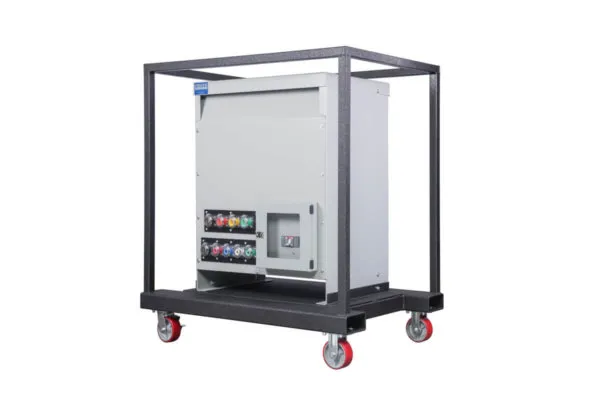News
What Is The Difference Between Step-Up and Step-Down Transformers?
Recognizing the need for a transformer often comes from someone working on a construction site, entertainment venue, sporting arena, or a location that requires a specific voltage, other than what is currently on-site, in order to power equipment or electrical devices. A transformer is an electrical box designed to convert alternating current (AC) from one voltage to another – (Low to High, or High to Low). There’s a transformer out there for pretty much everything nowadays – for example, there are minor transformers to power doorbells and LED lights all the way to large commercial machinery and equipment.
Whether you’re interested in a stand-alone Portable Transformer ranging from 15 KVa to 300 KVa or a fully loaded, customizable Transformer Cart with a safety switch disconnect, electrical distribution panel, and your preferred receptacles catered to better optimize your span of work. Our transformers are available in single-phase or three-phase arrangements for a step-up or step-down configuration, which we will go on to explain the differences in this blog article.
Step-Up Transformer
The main function of a step-up transformer is to convert (transform) a lower primary voltage to a higher secondary voltage. This is often the case on construction sites that require a higher voltage rating to power large industrial equipment at 480 volts. Also, industrial warehouses and other industrial buildings incorporate step-up transformers into their distribution systems to power industrial-scale LED lighting fixtures and high bays to cut down on energy expenses.
Step-Down Transformer
To simply explain the difference between these two, a step-down transformer is the exact opposite to that of a step-up transformer. Its main function is to convert a higher primary voltage to a lower secondary voltage. Often times, this will convert 277/480V to standard 120/208V for use with the necessary power tools and temporary power lighting throughout the jobsite or entertainment venue.
Reversing the Transformer Voltage
Now that we’ve covered the main difference in voltage between a step-up and step-down transformer, it’s important to realize that it is possible to configure either transformer backwards. This means that you can connect the secondary voltage side of your transformer with the appropriately sized cable to operate it in the reverse motion allowing a step-down transformer to operate as a step-up transformer and vice-versa. It’s important to consult a licensed and certified electrician to verify the proper wire gauge and voltage calculations to be sure that there is no damage done to the equipment along with the transformer itself. The capability to reverse a transformer makes these units perfect for widespread portable and temporary power connections to provide the voltage needed for the job no matter what.
If you find yourself on a jobsite that requires a transformer or other electrical distribution equipment to provide adequate power throughout the job, Power Assemblies is more than capable of innovating a power solution tailored to your needs. Power Assemblies sells strictly to authorized distributors and never to end-users. You can find an authorized Power Assemblies distributor near you by visiting our website, or you can call one of our sales engineers at (866)-825-8525 or email us anytime at [email protected] and our team will be happy to develop a solution for you.

